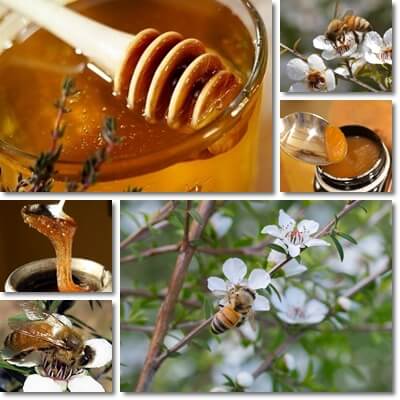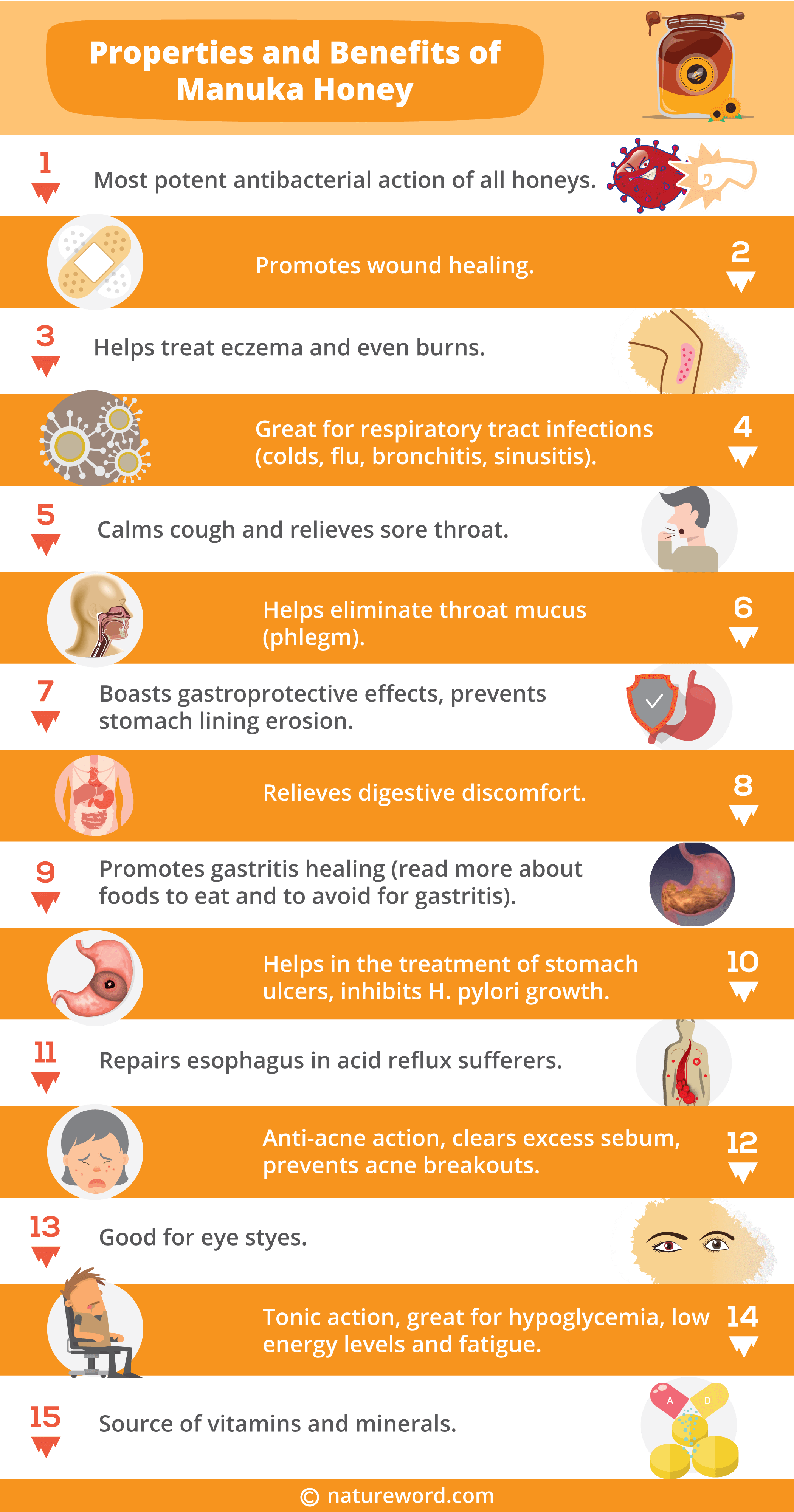The queen of all honeys, manuka is a highly prized monofloral variety with an amazing antibacterial action and a wide variety of health benefits. What sets manuka honey apart from all other varieties is its content of an antibacterial agent called methylglyoxal, a potent naturally-occurring antimicrobial with a far-reaching action. Eating manuka honey or using it topically in certain preparations and concentrations boasts a wide range of therapeutic effects, from treating respiratory tract infections and their symptoms to healing gastritis naturally. Moreover, the honey has a tonic, energizing action, helps fight fatigue and hypoglycemia and promotes wound and burn healing.
What is manuka honey? Manuka honey is a monofloral honey type made from the flower nectar and pollen of a shrub-like tree species called by the same name, manuka (Leptospermum scoparium). Alternative names include: manuka myrtle, tea tree or tea tree manuka (because a tea-like beverage was made from its leaves). The species is native to New Zealand and Australia and produces beautiful five-petaled, rounded, white and pink-speckled flowers rich in nectar. Real manuka honey is made from the flower nectar and pollen of manuka trees of the species Leptospermum scoparium and produced for the most part in New Zealand, but also Australia.

Other tree species from the same family as manuka, notably Kanuka or white tea tree (Kunzea ericoides) and tantoon or tea tree (Leptospermum polygalifolium) are an important source of nectar and produce a honey very similar to manuka in terms of composition, but also appearance. However, Kanuka honey from Kunzea ericoides and the so-called Australian manuka honey, Berringa honey or Jelly Bush honey from Leptospermum polygalifolium are not the same thing as the real New Zealand manuka honey, so make sure you check the label and origin of your honey to know what you are really eating. While they are not necessarily inferior to manuka (some say they may even hold similar properties, after all, they are made from the nectar of related species), these honeys are simply different from manuka honey.
What does manuka honey look like? The variety goes from a light amber (light brownish yellow) color with beige-cream undertones to a medium-amber (medium brownish yellow) with a pale brownish tone. Color may differ slightly depending on where and when the honey is produced and whether or not it may be contaminated with small amounts of flower nectar from other species. Processing, climate and weather conditions may also lead to small differences in appearance. Generally, manuka honey is lighter-colored than kanuka honey. Manuka honey has a slow crystallization time and forms coarse crystals. This has some producers cream the honey for a softer texture.
What does manuka honey taste and smell like? Manuka honey has an intense, but unique and wonderfully pleasant flavor profile. It has a medium sweetness, lasting taste and a slight bitter aftertaste with a faint oily-nutty base and warm, herbal notes. To me, the taste of manuka honey is somewhat reminiscent of halva, a Middle Eastern original dessert made from nut butter and sugar (commonly sunflower seed or sesame butter). It’s not heavy at all, but rather pleasant, intense and rich-flavored (think about sunflower honey, but with a richer flavor profile). If manuka honey is contaminated with eucalyptus nectar, then it may also have a slight minty, cool flavor, but not at all overpowering.
This is a normal occurrence because monofloral honeys are generally never made from a single flower nectar, but rather contain a predominant source of nectar and one or more secondary sources which may contribute to the overall taste with faint aromatic notes. A special trait of manuka honey is its consistency. Under normal conditions, the honey is thicker, like a gel (not runny, but viscous) and, if not moved, maintains this consistency. If it’s stirred, mixed or shaken, it tends to become less viscous, but resumes its consistency.

What is manuka honey good for?
The extremely potent antimicrobial effects of this honey variety recommend it for a wide variety of conditions and ailments that, for the most part, originate in bacterial infection. Use is internal, although the honey is being considered for more novel applications in the medical field (for instance, its active principle is believed to help develop products for faster wound healing). Find out below what the top 15 properties, uses and health benefits of manuka honey are.
1) Most potent antibacterial action of all honeys.
2) Promotes wound healing.
3) Helps treat eczema and even burns.
4) Great for respiratory tract infections (colds, flu, bronchitis, sinusitis).
5) Calms cough and relieves sore throat.
6) Helps eliminate throat mucus (phlegm).
7) Boasts gastroprotective effects, prevents stomach lining erosion.
8) Relieves digestive discomfort.
9) Promotes gastritis healing.
10) Helps in the treatment of stomach ulcers, inhibits H. pylori growth.
11) Repairs esophagus in acid reflux sufferers.
11) Anti-acne action, clears excess sebum, prevents acne breakouts.
12) Good for eye styes.
13) Tonic action, great for hypoglycemia, low energy levels and fatigue.
14) Source of vitamins and minerals.
15) Stimulates the immune system, immunomodulating effects.
Read more about the health benefits of manuka honey.

What is manuka honey UMF? Unique manuka factor, or UMF, is a special certification that measures the antibacterial activity of manuka honey. It is the highest certification of quality because it is the only official international verification system that grades the honey according to its antimicrobial action, its most important therapeutic benefit. And the honey owes its antimicrobial action to a compound called methylglyoxal, also known as the unique manuka factor because it is an element unique to manuka honeys. Not all manuka honeys have methylglyoxal, or in the same amount. This is why the UMF grading goes from UMF 5+ to UMF 10+, UMF 15+, UMF 20+ and UMF 25+.
What is manuka honey MGO? Methylglyoxal, or MGO, is the name of the main active antimicrobial constituent in manuka honey. The constituent was discovered by professor Thomas Henle from the Technical University of Dresden in Germany. The reason why the content of methylglyoxal is measured is to estimate the therapeutic benefits of the honey for the final consumer. As professor Henle revealed from his in vitro studies, 100 mg of MGO/ kg of manuka honey is the minimum content necessary to stop the growth of pathogenic bacteria such as E. coli or S. aureus. And the trademark grading system for the content of methylglyoxal in manuka honey goes from MGO 30+ to MGO 100+, MGO 250+, MGO400+ and MGO 550+. Moreover, depending on storage conditions, the methylglyoxal content of the honey may fluctuate.
What is manuka honey KFactor? KFactor is a manuka honey grading that sets out to grade the purity of manuka honey, not its medicinal properties. KFactor basically measures the pollen content of the honey, in the idea that the more manuka pollen the honey contains, the higher its purity and, naturally, the stronger its therapeutic action. The grading system goes from K12 (with a minimum of about 65% manuka pollen) to K16 (75%) and K22 (90%).
What is BioActive, TA or A manuka honey? It is another grading of manuka honey, but offers no certified guarantee of its properties or therapeutic activity. For more detailed information on the grading systems of manuka honey and how they equivalate with one another, read the article Manuka Honey UMF, MGO, KFactor.
Manuka honey and allergies
Anyone allergic to manuka flower pollen will automatically be allergic to manuka honey. Anyone allergic to honey bee enzymes (produced by bees in order to make honey) is automatically allergic to manuka and other honeys, but also to other bee products such as royal jelly, propolis, bee bread or beeswax.
Conclusion
The therapeutic action of manuka honey is a direct result of a unique antibacterial composition abounding in a naturally potent antimicrobial element called methylglyoxal (MGO, for short). It is this special composition that accounts for the honey’s effectiveness in treating or helping manage various conditions, from respiratory infections such as sinusitis or the common cold to gastritis, stomach ulcers, acne and even burns and wounds. The honey even helps repair the esophagus in acid reflux sufferers and treat eye styes or eczema. And although a 250 g or 500 g jar might seem unjustly small for its high price (50-120 $), the health benefits it bestows on us are incomparable.
